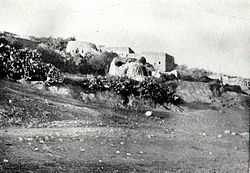Indur
| Indur | |
|---|---|
|
Indur in the 1890s. | |
 Indur | |
| Arabic | إندور/عين دور |
| Name meaning | Endor[1] |
| Also spelled | Endor |
| Subdistrict | Nazareth |
| Coordinates | 32°38′11.32″N 35°22′52.55″E / 32.6364778°N 35.3812639°ECoordinates: 32°38′11.32″N 35°22′52.55″E / 32.6364778°N 35.3812639°E |
| Palestine grid | 186/227 |
| Population | 620 (1945) |
| Area |
12,444 dunams 12.4 km² |
| Date of depopulation | 24 May 1948[2] |
| Cause(s) of depopulation | Military assault by Yishuv forces |
| Secondary cause | Influence of nearby town's fall |
| Current localities | None |
Indur (Arabic: إندور) was a Palestinian village, located 10.5 kilometres (6.5 mi) southeast of Nazareth. Its name preserves that of ancient Endor, a Canaanite city state thought to have been located 1 kilometre (0.62 mi) to the northeast.[3] The village was depopulated during the 1948 Arab–Israeli War and its inhabitants became refugees, some of whom were internally displaced. In Israel today, there are a few thousand internally displaced Palestinians who hail from Indur, and continue to demand their right of return.
Etymology
The name of this village preserves that of the ancient Canaanite city of Endor mentioned in the Bible as the place King Saul encountered a known medium. While a few scholars believe that Indur is the actual site of ancient Endor, many believe that Khirbet Safsafa, located 1 kilometre (0.62 mi) to the northeast, is a more likely candidate.[3][4][5]
History
In 1596, Indur was a part of the Ottoman nahiya ("subdistrict") of Shafa under the liwa' ("district") of Lajjun with a population of twenty-two. It paid taxes on a number of crops, including wheat, barley and olives, as well as goats and beehives.[6] A map by Pierre Jacotin from Napoleon's invasion of 1799 showed the place, named as Handourah.[7]
By the late nineteenth century, the village was made of adobe bricks, built against a steep hillside. To the east of the village there were several caves. [8]
In Ottoman era Palestine, an elementary school was founded in Indur, but was closed during the British Mandate in Palestine.[9] Sheikh Tawfiq Ibrahim, one of the leaders of the 1936–39 Arab revolt in Palestine and an associate of Izz ad-Din al-Qassam, was from Indur.[9]
The village was occupied by Israel's Golani Brigade on May 24, 1948. The Golani Brigade went on "cleansing and defending" the area until early June.[9]
Today
During the 2004 commemorations of Nakba Day held by Palestinian Arab citizens of Israel, the annual right of return march led to Indur.[10] Jewish Israelis joined in the march and the event received coverage by Israeli cable and Arab satellite TV stations.[10]
Indur's former residents and their descendants number a few thousand from among the tens of thousands of internally displaced Palestinians within Israel today.[10]
See also
- List of Arab towns and villages depopulated during the 1948 Palestinian exodus
- List of villages depopulated during the Arab–Israeli conflict
References
- ↑ Palmer, 1881, p. 161
- ↑ Morris, 2004, p. xvii, village #110. Also gives causes of depopulation.
- ↑ 3.0 3.1 Mazar, 1971, p. 318.
- ↑ Negev and Gibson, 2005, p. 166.
- ↑ Freedman, et al., 2006, p. 406.
- ↑ Hütteroth and Abdulfattah, 1977, p. 157. Quoted in Khalidi, 1992, p. 344.
- ↑ Karmon, 1960, p. 167.
- ↑ Conder and Kitchener, 1882, SWP II, pp. 83 - 84. Quoted in Khalidi, 1992, p.346
- ↑ 9.0 9.1 9.2 Khalidi, 1992, p. 346
- ↑ 10.0 10.1 10.2 Annual Return March in the Galilee (PDF), Issue No. 22, Badil, June 2004, p. 8.
Bibliography
| Wikimedia Commons has media related to Indur. |
- Barron, J. B., ed. (1923). Palestine: Report and General Abstracts of the Census of 1922 (PDF). Government of Palestine.
- Conder, Claude Reignier; Kitchener, H. H. (1882). The Survey of Western Palestine: Memoirs of the Topography, Orography, Hydrography, and Archaeology 2. London: Committee of the Palestine Exploration Fund.
- Freedman, David Noel; Myers, Allen C.; Beck, Astrid B. (2000). Eerdmans dictionary of the Bible (Illustrated ed.). Wm. B. Eerdmans Publishing. ISBN 0-8028-2400-5.
- Hadawi, Sami (1970). Village Statistics of 1945: A Classification of Land and Area ownership in Palestine. Palestine Liberation Organization Research Center.
- Hütteroth, Wolf-Dieter; Abdulfattah, Kamal (1977). Historical Geography of Palestine, Transjordan and Southern Syria in the Late 16th Century. Erlanger Geographische Arbeiten, Sonderband 5. Erlangen, Germany: Vorstand der Fränkischen Geographischen Gesellschaft. ISBN 3-920405-41-2.
- Karmon, Y. (1960). "An Analysis of Jacotin's Map of Palestine" (PDF). Israel Exploration Journal 10 (3,4): 155–173; 244–253.
- Khalidi, Walid (1992). All That Remains: The Palestinian Villages Occupied and Depopulated by Israel in 1948. Washington D.C.: Institute for Palestine Studies. ISBN 0-88728-224-5.
- Mills, E., ed. (1932). Census of Palestine 1931. Population of Villages, Towns and Administrative Areas (PDF). Jerusalem: Government of Palestine.
- Morris, Benny (2004). The Birth of the Palestinian Refugee Problem Revisited. Cambridge University Press. ISBN 0-521-00967-7.
- The Encyclopedia Americana. Grolier Incorporated. 2000.
- Mazar, Benjamin (1971). The world history of the Jewish people. Allen. ISBN 0-491-00364-1.
- Negev, Avraham; Gibson, Shimon (2005). Archaeological Encyclopedia of the Holy Land (Illustrated, revised ed.). Continuum International Publishing Group. ISBN 0-8264-8571-5.
- Palmer, E. H. (1881). The Survey of Western Palestine: Arabic and English Name Lists Collected During the Survey by Lieutenants Conder and Kitchener, R. E. Transliterated and Explained by E.H. Palmer. Committee of the Palestine Exploration Fund.
External links
- Welcome To Indur
- Survey of Western Palestine, Map 9: IAA, Wikimedia commons
- The District of Nazareth at Khalil Sakakini Cultural Center
- Ndoor Dr. Moslih Kanaaneh
